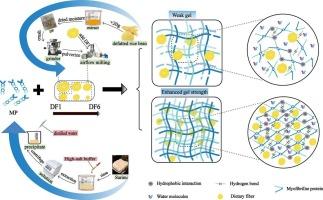Micronization of defatted rice bran dietary fiber and its particle size effect on the structure and physicochemical properties of myofibrillar proteins
IF 9.8
1区 农林科学
Q1 CHEMISTRY, APPLIED
引用次数: 0
Abstract
This study investigated the effects of defatted rice bran dietary fiber particle size (D50 111.01–8.85 μm) on silver carp myofibrillar protein structure and gelation. Smaller particles enhanced the ordered secondary structure, with α-helix and β-sheet contents increasing by 45.7 % and 16.6 %. The primary modes of action were enhanced surface area interactions and tertiary structure unfolding, resulting in a 108 % increase in exposed sulfhydryl groups and greater surface hydrophobicity. As particle size decreased, turbidity increased from 0.43 to 0.89 and mean particle diameter from 342 to 535 nm, indicating larger protein aggregates. Fine fibers facilitated protein cross-linking into dense, continuous gel networks, as evidenced by FTIR, fluorescence, and SEM analyses. Practical applications include improving surimi texture uniformity, elasticity, and water-holding capacity while valorizing rice bran by-products. This study proposes a particle size–structure–function mechanism for DF–MP interaction to be optimized and verified via sensory quality, storage stability, and industrial scalability.

脱脂米糠膳食纤维的微粉化及其粒径对肌原纤维蛋白结构和理化性质的影响
本试验研究了脱脂米糠膳食纤维粒径(D50 111.01-8.85 μm)对鲢鱼肌原纤维蛋白结构和凝胶化的影响。颗粒越小,二级结构越有序,α-螺旋和β-片的含量分别提高了45.7% %和16.6% %。主要的作用模式是增强表面积相互作用和三级结构展开,导致暴露的巯基增加108 %,表面疏水性增强。随着粒径的减小,浊度从0.43增加到0.89,平均粒径从342增加到535 nm,表明蛋白质聚集体变大。FTIR、荧光和扫描电镜分析证明,细纤维促进蛋白质交联成致密、连续的凝胶网络。实际应用包括改善鱼糜质地均匀性、弹性和保水能力,同时使米糠副产品增值。本研究提出了DF-MP相互作用的粒径-结构-功能机制,通过感官质量、储存稳定性和工业可扩展性来优化和验证。
本文章由计算机程序翻译,如有差异,请以英文原文为准。
求助全文
约1分钟内获得全文
求助全文
来源期刊

Food Chemistry
工程技术-食品科技
CiteScore
16.30
自引率
10.20%
发文量
3130
审稿时长
122 days
期刊介绍:
Food Chemistry publishes original research papers dealing with the advancement of the chemistry and biochemistry of foods or the analytical methods/ approach used. All papers should focus on the novelty of the research carried out.
 求助内容:
求助内容: 应助结果提醒方式:
应助结果提醒方式:


